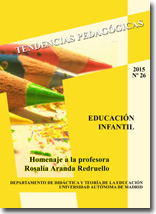Palabras clave:
suma, resta, operaciones aritméticas, educación infantil, educación matemáticaResumen
Se estudia el proceso que va desde las acciones reales y efectivas de añadir y quitar hasta la construcción de las operaciones aritméticas de suma y resta por parte de los escolares de 3, 4 y 5 años. El esquema lógico–matemático subyacente es el de transformaciones. Para que se den estas operaciones deben presentarse simultáneamente dicho esquema y la cuantificación, siendo esa simultaneidad la que lleva a las relaciones numéricas. Teniendo en cuenta que el origen de las operaciones de suma y resta en el escolar está supeditado a las acciones de añadir y quitar que se desarrollan en un proceso de construcción mental de los esquemas lógicos-matemáticos de transformaciones de cantidades discretas, se propone un plan de actuación en el aula de educación infantil mediante un tratamiento sistemático de dichas operaciones.
Descargas
Citas
Canobi, K., Reeve, R. & Pattison, P. (2003). Patterns of Knowledge in Children's Addition. Developmental Psychology, 39(3), 21-34.
Canobi, K.(2004). Individual Differences in Children's Addition and Subtraction Knowledge.Cognitive Development, 19(1), 81-93.
Carpenter, T. P. & Moser, J.M. (1979). An investigation of de learning of addition and subtraction. Madison: Wisconsi Research and Development Center for Individualizad Schooling.
Carpenter, T. P. Fennema, E. et al (1999). Children’s Mathematics. Cognitively Guided Instrction.Prtsmouth, NH: Heinemann.
Dickson, L., Brown, M. & Gibson. O. (1991). El aprendizaje de las matemáticas. Cerdanyola: Editorial Labor, S.A.
Fernandez, C. (2001). Aprendizajes numéricos en el ámbito familiar. En A. Gervilla, M. Barreales, R. Galante & Martinez, I.(Eds.), Familia y Educación (pp. 339-348). Málaga: HUM 205.
Fernández, C. (2007). ¿Cómo y cuándo abordar la didáctica de las operaciones de suma y resta?. Bordón, 59(1), 63-80.
Ginsburg, H. & Pappas, S. (2004). SES, Ethnic, and Gender Differences in Young Children's Informal Addition and Subtraction: A Clinical Interview Investigation. Journal of Applied Developmental Psychology, 25(2), 171-192
Hughes, M. (1981). Can Pre-School Children Add and Subtract?. Educational Psychology, 1(3), 207-219.
Mccrink, K. & Wynn, K. (2004). Large, number addition and subtraction by 9-month-old infants. Psycological Science, 15, 776-781.
Mialaret, G. (1984). Las Matemáticas cómo se aprenden, cómo se enseñan. Madrid: Aprendizaje Visor.
Naito, M. & Miura, H. (2001). Japanese Children's Numerical Competencies: Age- and Schooling-Related Influences on the Development of Number Concepts and Addition Skills. Developmental Psychology, 37(2), 17-30.
Robinson, K. (2001). The Validity of Verbal Reports in Children's Subtraction. Journal of Educational Psychology.93 (1), 211-222.
Starkey, P. & Gelman, R. (1982). The development of addition and subtraction abilities prior to formal schooling in arithmetic. En T. Carpenter, J. Moser & T. Romberg (Eds). Addition and subtraction: A cognitive perspective. (pp. 99-116). Hillsdale, Nueva Jersey: Lawrence Erlbaum Associates.
Vergnaud, G. (1985). L'enfant, la mathématique et la réalité. New York: Peter Lang.
Vilette, B. (2002). Do young children grasp the inverse relationship between addition and subtraction? Evidence against early arithmetic. Cognitive Development, 17, 1365-1383.
Zur, O. & Gelman, R. (2004). Young Children Can Add and Subtract by Predicting and Checking. Early Childhood Research Quarterly, 19(1),121-137.
